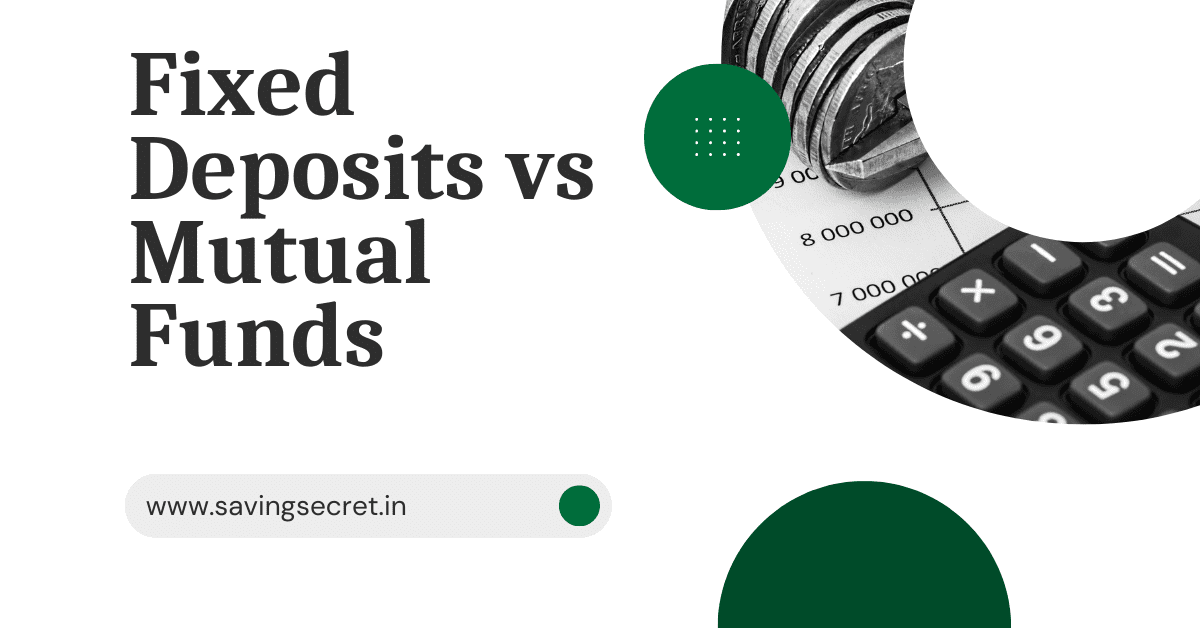Fixed Deposits vs Mutual Funds: One of the best strategies to safeguard your financial future is to invest your hard-earned money, particularly in a rapidly expanding market like India. Despite the vast array of possibilities, mutual funds and fixed deposits (FDs) are two of the most well-liked investment options for Indian investors. However, how can you choose the one that works best for you? Which is better, the growing potential of mutual funds or the assured earnings of an FD? This comprehensive guide contrasts mutual funds with fixed deposits, analysing their characteristics, advantages, dangers, and appropriateness to assist you in making wise and well-informed financial decisions.
Understanding Fixed Deposits (FDs): A Safe Haven for Indian Investors
For many years, fixed deposits have been a vital component of Indian households’ financial planning. An FD, which is provided by banks, post offices, and non-banking financial companies (NBFCs), entails making a lump sum deposit at a predefined interest rate for a set period of time. No matter where you are—in Delhi, Mumbai, or a tiny town—FDs are a byword for dependability and safety.
How FDs Operate:

- For example, you deposit ₹50,000 for a duration of one, five, or ten years.
- Depending on the bank and duration, interest payments from the bank range from 5% to 8% annually (as of March 2025).
- You get your principal plus interest when it matures.
Important Fixed Deposit Features:
- Fixed Returns: Predictable profits are guaranteed since interest rates are fixed at the time of investment.
- Tenure Flexibility: To accommodate both short-term and long-term requirements, options span from seven days to ten years.
- Safety: FDs up to ₹5 lakh per depositor are protected by the Deposit Insurance and Credit Guarantee Corporation (DICGC), which is governed by the Reserve Bank of India (RBI).
- Taxation: Depending on your income tax slab, interest is taxed. However, Section 80C allows for deductions of up to ₹1.5 lakh for Tax-Saving FDs with a 5-year duration.
- Liquidity: Although it is feasible, early withdrawal frequently results in fines.
India’s Leading FD Providers:
State Bank of India (SBI) and Punjab National Bank (PNB) are examples of public sector banks.
Private financial institutions like as Axis Bank, ICICI Bank, and HDFC Bank.
Competitive rates (e.g., 7.5% for 5 years in 2025) are offered by Post Office FDs.
Understanding Mutual Funds: A Key to Wealth Creation
Over the past 10 years, mutual funds have been incredibly popular in India because of their flexibility and potential for larger returns. A mutual fund, which is overseen by qualified fund managers, aggregates the capital of several participants and allocates it among a variety of stocks, bonds, and other instruments.
The Operation of Mutual Funds:

- Either a flat payment or a Systematic Investment Plan (SIP) with a monthly investment of, say, ₹1,000 are your options.
- Your money is distributed across assets by the fund management according to the fund’s goal (e.g., equities, debt, or hybrid).
- The type of fund and market performance determine returns.
Important Mutual Fund Features:
- Variable Returns: Over an extended period, debt funds may yield 6-8% yearly, whereas equity funds may yield 10-15%.
- Types include debt funds (low risk, steady return), hybrid funds (balanced), equity funds (high risk, high return), and others.
- Risk: Market-linked, which means that returns change in response to the state of the economy.
- Taxation: Gains from debt funds are taxed according to your income tax bracket, while long-term capital gains (LTCG) from equity funds above ₹1.25 lakh are taxed at a rate of 12.5%.
- Liquidity: While some mutual funds have exit loads or lock-in periods (such as three years for ELSS), the majority permit redemption at any time.
Popular Indian Mutual Funds:
- Equity funds include the Mirae Asset Large Cap Fund and the SBI Bluechip Fund.
- Debt funds include the ICICI Prudential Savings Fund and the HDFC Short Term Debt Fund.
- Kotak Balanced Advantage Fund is a hybrid fund.
A Comparative Analysis of Mutual Funds and Fixed Deposits
Let’s compare fixed deposits and mutual funds in-depth using several important criteria so that you can make an informed investing decision:
| Parameter | Fixed Deposits | Mutual Funds |
| Returns | Fixed Returns (5–8% annually) | Variable (6–15% annually, dependent on the market) |
| Risk | Low risk (protection of capital) | Market risk is moderate to high |
| Liquidity | Limited liquidity (fine for early withdrawal) | High (subject to exit load, redeemable at any moment) |
| Minimum Investment | The minimal amount of money invested Commencing at ₹1,000 | SIPs starting at ₹500 or a lump payment |
| Tenure | Fixed tenure, such as 1 to 10 years | Open-ended (or flexible) finances |
| Tax Benefits | Part 80C for five-year FDs | Under Section 80C, ELSS funds |
| Suitability | Adequacy Investors that are risk averse | Investors focused on growth |
Fixed Deposits: The advantages and disadvantages
Fixed Deposit benefits include:

- Guaranteed Returns: FDs are a dependable option during uncertain times since they provide guaranteed returns. Your interest rate doesn’t change if the stock market plummets or inflation soars.
- Capital Safety: Even in the event that the bank experiences financial difficulties, your money is protected by DICGC insurance up to ₹5 lakh.
- Variable Tenure Choices: FDs accommodate a range of financial timescales, from short-term (e.g., one year) to long-term (e.g., ten years).
- Senior Citizen Benefits: FDs are a popular retirement option since banks such as SBI, HDFC, and ICICI give greater interest rates (up to 8.5% p.a.) for people over 60.
Loan Facility: In times of need, you can borrow up to 90% of your FD balance without forfeiting your deposit.
Fixed Deposits’ Drawbacks:
- Reduced Returns: Over time, real returns are eroded by FDs’ inability to keep up with inflation, which is normally between 4% and 6% in India, and interest rates that range from 5% to 8%.
- Tax Burden: Net profits are decreased when interest is applied to taxable income and taxed according to your slab (for example, 30% for high earners).
- Limited Liquidity: Making an early withdrawal limits your flexibility by lowering your interest rate or resulting in a penalty.
- No Creation of capital: FDs may not provide the compounding advantages of market-linked investments, but they do protect capital.
Mutual Funds: Benefits and Drawbacks
Mutual fund advantages include:
- Greater Return Potential: Over the past ten or more years, equity mutual funds, such as large-cap or mid-cap funds, have produced 12%–15% annualised returns, significantly outpacing inflation.
- Diversification: MFs distribute risk by investing in a variety of stocks, bonds, or both, lessening the impact of a single asset’s underwhelming performance.
- Affordable Entry: SIPs make MFs accessible to small investors by allowing you to begin with as little as ₹500 per month.
- Tax Efficiency: Long-term capital gains (LTCG) over ₹1 lakh are subject to just 10% tax, while equity-linked savings schemes (ELSS) provide tax deductions up to ₹1.5 lakh under Section 80C.
- Compounding power is used by regular SIP investments to transform modest sums of money into substantial wealth over many years.
Mutual fund disadvantages include:
Market Volatility: Gains can be undermined by a bad market, particularly in equities funds; returns are not certain.
Management Fees: Although direct plans through platforms like Groww or Zerodha minimise this cost, expense ratios (usually 1%–2% p.a.) lower your net gains.
Knowledge Barrier: Selecting the best fund necessitates investigation or professional guidance, which can be intimidating for novices.
Lock-in Periods: While most open-ended funds provide flexibility, some, such as ELSS (3 years), limit liquidity.
Taxation: What You Should Know About FD vs. MF
Your net returns are heavily influenced by tax consequences. This is how FDs and MFs compare:
Fixed Deposits:
- Depending on your income tax bracket (e.g., 5%, 20%, or 30%), interest on fixed deposits is completely taxed.
- If interest reaches ₹40,000 per year (₹50,000 for elderly folks), Tax Deducted at Source (TDS) is applicable.
- There are no tax-saving advantages.
Mutual Funds:
- Equity Funds: 10% tax on LTCG above ₹1 lakh (without indexation); 15% tax on STCG (holding for less than a year).
- Debt funds: STCG according to your slab; LTCG (holdings >3 years) taxed at 20% with indexation.
- ELSS Funds: Section 80C provides a three-year lock-in tax deduction of up to ₹1.5 lakh.
MFs, particularly equity funds, are frequently more tax-efficient than FDs for high-income taxpayers.
For whom are fixed deposits the best option? FDs are best if:
- You desire peace of mind and value safety over large profits.
- You’re setting aside money for immediate objectives, like as a wedding or trip in the next one to three years.
- You’re an elderly person or retiree looking for a steady, reliable source of income.
- You’re a novice who prefers a hands-off approach and is cautious about market hazards.
For instance, a 65-year-old retiree puts ₹10 lakh into a five-year, 7.5% annual percentage rate (p.a.) SBI FD. They have no danger to their principle and make ₹75,000 a year, taxed at their slab.
For whom are mutual funds appropriate?
MFs work well for you if:
- Your goal is to build money over the long run, such as for your child’s schooling or retirement in ten to twenty years.
- You feel at ease taking on moderate to high risk in exchange for maybe greater returns.
- You want the advantages of SIPs for disciplined investment together with flexibility.
- As a young professional, you have time to weather market fluctuations.
A 30-year-old, for instance, begins a ₹5,000 monthly systematic investment plan (SIP) in a large-cap fund that has an average return of 12%. Compounding allows their ₹12 lakh investment to increase to exceed ₹50 lakh in 20 years.
How can you get started in India?
Regarding Fixed Deposits:
- Where: Banks (SBI, HDFC, ICICI), post offices, or NBFCs (Bajaj Finance, Mahindra Finance) can all provide investments.
- How: For online FDs, which frequently provide greater rates (e.g., 7.8% vs. 7.5%), visit a branch or use net banking.
- Tools: Check rates on the websites of banks or on BankBazaar and Paisabazaar.
For mutual funds:
- Where: Invest through distributors registered with AMFI or through websites such as Groww, Zerodha Coin, and Kuvera.
- How: Create an account, do KYC, and choose a fund according to your objectives (e.g., HDFC Short Term Debt for stability, Mirae Asset Large Cap for growth).
- Investigate: Look into expense ratios, fund manager repute, and historical performance on Morningstar or Value Research.
Blending FDs with MFs: The Equitable Method
- When you can combine the two, why pick just one? A diverse portfolio maximises profits while reducing risk:
- If you are risk averse, allocate 60–70% to FDs for stability.
- If you are a young person or growth-oriented, invest 30–40% in mutual funds (MFs), such as equities or hybrid funds.
- For instance, to balance safety and wealth generation, a ₹20 lakh portfolio may be divided into ₹12 lakh in FDs (7% p.a.) and ₹8 lakh in an equities fund (12% p.a.).
Conclusion: FD or MF in 2025?
Your decision in India’s changing financial environment is based on your priorities. Mutual funds are great for long-term growth, tax efficiency, and youthful investors, while fixed deposits are best for retirees, short-term objectives, and safety. With markets exhibiting resilience and inflation at 5%–6% in 2025, a hybrid strategy that combines FDs for stability and MFs for growth would be your best bet.
Now is the time to start! Determine your goals, evaluate your risk tolerance, and, if necessary, get advice from a financial counsellor. Your financial future is waiting for you, whether it’s the thrilling possibility of an MF or the certain comfort of an FD!
How to Start SIP with 500 Rupees: A Beginner’s Guide for Indians
LIC Investment in Stock Market: Secrets of India’s Biggest Investor!

